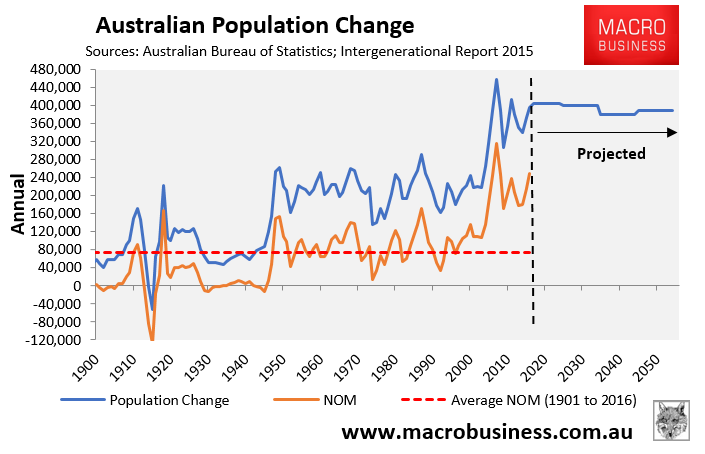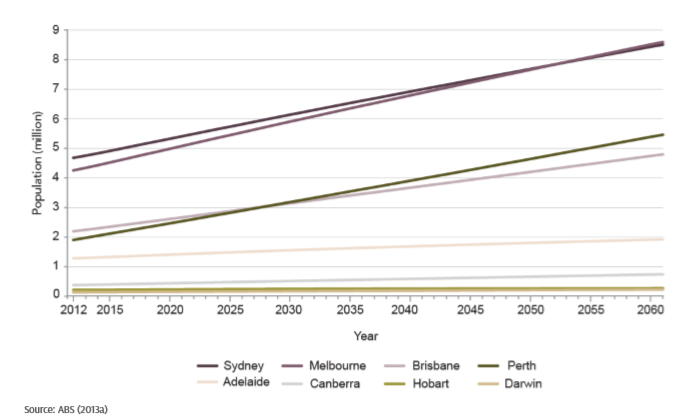Over the past month or so, we witnessed several ‘authorities’ warn that Australia’s infrastructure is failing in the face of strong immigration-fuelled population growth.
First, we heard from outgoing Infrastructure Australia (IA) CEO, Philip Davies:
Mr Davies said if planning for major projects did not change at all levels of government, the major capitals would not cope with the population growth.
“An additional 11.8 million people will call Australia home in the next 30 years, with the bulk of this growth occurring in our largest cities — Sydney, Melbourne, Brisbane and Perth,” Mr Davies said.
“The reality is, if we don’t improve the way we plan and deliver our infrastructure, we won’t cope with this growth and our cities will be characterised by congestion and constraint.
…When asked if he could cite a project that had stacked up to the 11 principles outlined in the document to be published today, Mr Davies said to date there had been none that had adhered to the best-practice model.
Then we heard from the Australian Chamber of Commerce and Industry (ACCI) CEO, James Pearson:
”The problems current policies have caused are well known and include:
- Congestion in schools, on roads, on public transport, recreation areas and other amenities.
- An ever-growing mountain of money thrown simply to offset problems of congestion. This is money we could otherwise be spending on genuine nation-building infrastructure, not simply playing catch-up and offsetting congestion.
- The growing housing affordability crisis – especially in Sydney and Melbourne
- Housing affordability problems, in turn, lead to higher household debt as families take on ever larger loans to buy-in. It’s also led to a narrow and divisive tax debate and calls to restrict negative gearing and capital gains tax.
- Calls to cut immigration and restrict population growth.
“Our population is highly concentrated and on current Australian Bureau of Statistics projections, Sydney and Melbourne could each have a population around 8 million by 2050 and over 10 million each by 2075,” Mr Pearson said.
Next, we heard from the Grattan Institute’s Transport Fellow, Hugh Batrouney:
Given how fast our big cities are growing, we simply can’t afford to make decisions based on limited or misleading information. Yet this keeps happening…
The most commonly cited estimates of the “avoidable costs” of congestion in Australia come from the Bureau of Infrastructure, Transport and Regional Economics. In 2015, BITRE estimated the annual costs for Australia’s eight capitals totalled about A$16.5 billion. This was forecast to rise to about A$30 billion by 2030.
Such estimates have been important in highlighting the fact that congestion is not just aggravating but costly…
Getting transport projects right is critically important in cities that are already under pressure. Yet too many big infrastructure calls in Australia are based on misleading information or wafer-thin evidence. We need to do better.
And finally, we heard from Fairfax’s economics editor, Ross Gittins:
It’s the great conundrum of government policy: we have a big shortage of infrastructure, but also waste billions on it.
This seeming contradiction is easily explained: particularly in recent years, and at both state and federal levels, much money is being spent on infrastructure projects.
Trouble is, a lot of the dough’s being spent on flashy or low-priority projects, at the expense of more important but less sexy projects, particularly in the overcrowded outer suburbs…
There aren’t many aspects of government spending – many contributors to debt and deficit – more in need of reform than spending on public infrastructure, or with more scope for making a bigger contribution to national productivity and a smaller contribution to budget pressures…
The Weekend Australian ran a detailed report entitled “Price of progress: a mess”, which questioned whether Australia’s cities can build their way out of planned manic immigration-fuelled population growth:
Clogged traffic, packed public transport and eye-watering property prices are causing the growth pain that underpins the debate over immigration levels and jitters about Australia’s upsizing. But that’s only half of the equation, the demand side, and unless there is a shift in government policy to slam the door on migrants and foreign students it will remain a given.
The supply side is where the difference can be made through masterplanning and infrastructure provision. And the numbers there are starting to stack up…
The question is, does this staggering investment in the future represent mere catch-up on the infrastructure lag bedevilling Australia’s big cities or genuine progress to retain their liveability?…
Demographer Bernard Salt says… we need to be world’s best practice at city planning and Western car-based city infrastructure delivery. And if we are not then our cities will collapse under their own weight”…
…As former NSW Labor premier Bob Carr points out, the Berejiklian braggadocio is belied by the fact that after seven years in office, the state government has yet to “cut a ribbon” on one major project… He says “every cent” of increased funding for infrastructure has been raised by a fire sale of the state’s electricity assets and ports. But the proceeds have been “squandered” on the wrong projects: from the “entirely unnecessary” light rail for Sydney’s eastern suburbs to the $8bn Middle Harbour tunnel project.
All the while, the scramble to keep up with housing demand has led to an explosion in “forests of high-rise towers” across Sydney. “The stately march of the towers threatens to swamp every new infrastructure investment”…
Carr says then, as now, no amount of infrastructure spending could outpace the continuing migrant influx to Sydney and Melbourne. “What’s missing in this debate is a good dose of honesty,” he argues…
The fact of the matter is that Australia’s governments can never build enough infrastructure to keep pace with such strong population growth, given Australia is projected to add roughly a Canberra’s worth of people every year until mid-century:
With Australia’s major cities projected to attract the lion’s share of this growth:
The reasoning is simple: in already built-out cities like Sydney and Melbourne, the cost of retrofitting new infrastructure to accommodate greater population densities is prohibitively expensive because of the need for land buy-backs, tunnelling, as well as disruptions to existing infrastructure.
Bernard Salt explicitly highlighted this point in the article above:
As Salt points out, subway construction is jaw-droppingly expensive. The new 11km Metro tunnel to “untangle” the existing City Loop rail link works out at $1m a metre, 10 times the cost of line construction above ground. “They are extraordinary numbers, and that’s why this is the big issue,” he says…
Indeed, a 2013 report by the Productivity Commission (PC) warned that total private and public investment requirements over the next half century are estimated to be more than 5-times the cumulative investment made over the last half century:
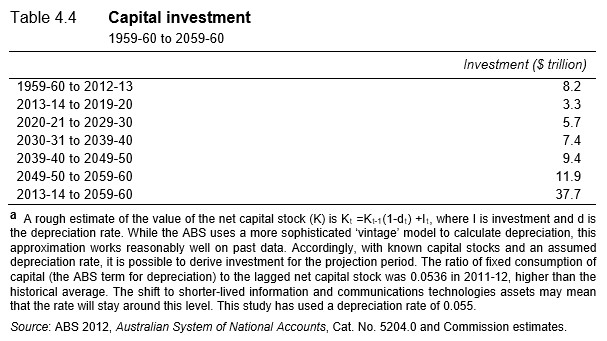
The PC’s 2016 Migrant Intake into Australia report explicitly noted that infrastructure will have to increase to accommodate a bigger population, and that this infrastructure will necessarily be expensive:
Physical constraints in major cities make the costs of expanding infrastructure more expensive, so even if a user-pays model is adopted, a higher population is very likely to impose a higher cost of living for people already residing in these major cities.
…governments have not demonstrated a high degree of competence in infrastructure planning and investment. Funding will inevitably be borne by the Australian community either through user-pays fees or general taxation…
Whereas, the PC’s recent Shifting the Dial: 5 year productivity review explicitly noted that infrastructure costs will inevitably balloon due to our cities’ rapidly growing populations:
Growing populations will place pressure on already strained transport systems… Yet available choices for new investments are constrained by the increasingly limited availability of unutilised land. Costs of new transport structures have risen accordingly, with new developments (for example WestConnex) requiring land reclamation, costly compensation arrangements, or otherwise more expensive alternatives (such as tunnels).
Of course, we also cannot forget Infrastructure Australia’s recent report, which found that both Melbourne’s and Sydney’s living standards will be crushed as their populations surge to 7.3 million and 7.4 million by 2046, regardless of how they grow, with worsening congestion and reduced access to jobs, hospitals, schools and green space:
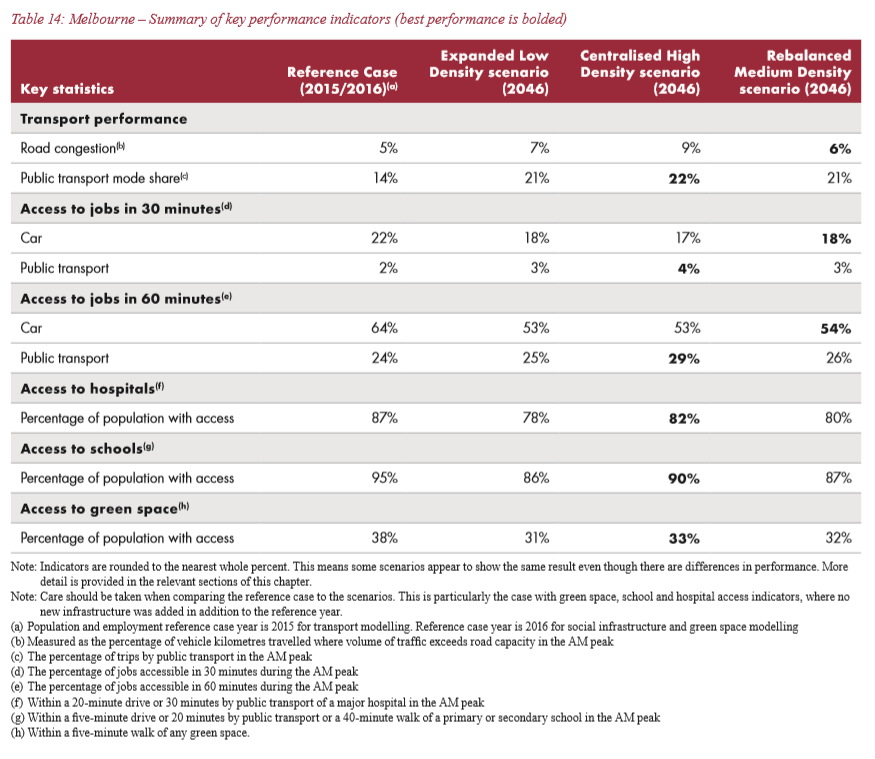
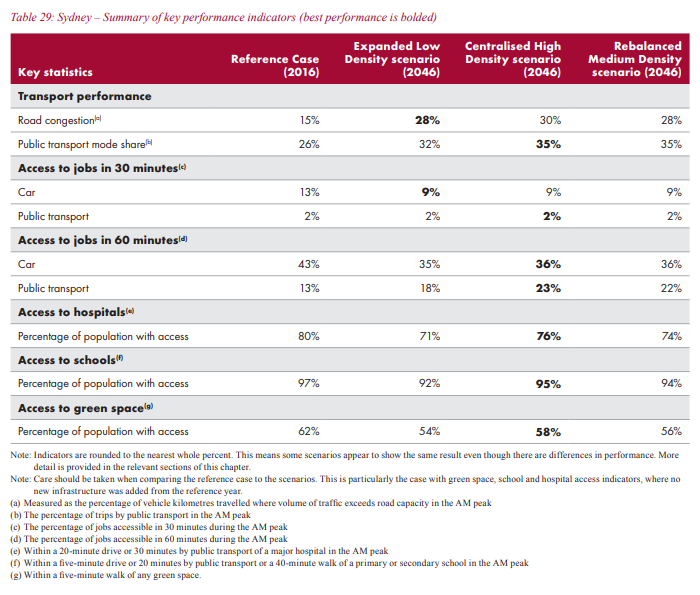
Clearly, it is the federal government that carries the primary blame for Australia’s infrastructure woes arising from rapid population growth, due to its mass immigration ‘Big Australia’ policy.
The most obvious and least cost policy solution, therefore, is to significantly dial back Australia’s immigration program and forestall the need for costly new infrastructure projects in the first place.
Population boosters like IA, the ACCI, Grattan and Bernard Salt can’t credibly endorse mass immigration and then turn around and complain about expensive infrastructure projects. They are directly linked. Australia cannot build its way out of this mess.

